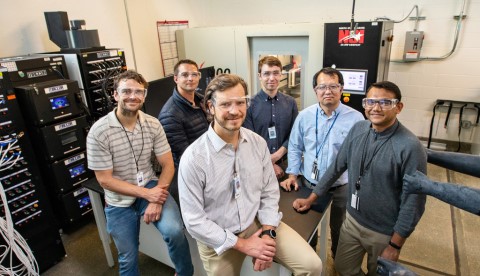Scientist Maps Battery Data for Optimized Energy Storage Solutions
There are many ways to map the world, from geographic illustrations to the genetic makeup of the organisms around us. As an avid outdoorsman, hiker, and mountain biker, it is natural that National Renewable Energy Laboratory (NREL) Scientist Kandler Smith would also apply these concepts to his research. Smith leads NREL’s battery computational modeling for electrochemical energy storage, where he designs maps and models to improve our understanding of batteries.
“Working in sustainable energy is one small way I can help preserve the natural world,” Smith said. “I enjoy the puzzle of designing and accelerating the design of safe, reliable, and efficient batteries for grid and transportation decarbonization.”

With 15 years at NREL, Smith is an expert in predicting and extending the lifetime of lithium-ion batteries, but electrochemical energy storage was not always his passion. Smith started his career in mechanical engineering, working on jet engines for military programs, before shifting focus to renewable energy. After earning a Ph.D. in mechanical engineering from Pennsylvania State University, he joined NREL.
“I was originally interested in building machines, like helicopters,” Smith said. “But the subjects of thermodynamics and heat transfer sparked my interest in energy and, later, electrochemistry. Instead of building engines, I began building computer models to design better batteries for a sustainable future.”
Nestled in the sunny Colorado foothills, NREL is a natural fit for Smith’s environmental passions, both professionally and recreationally. At NREL, Smith has assisted in developing numerous battery models, including the ambitious Computer-Aided Engineering of Batteries (CAEBAT) project. The CAEBAT project has supported the development of laboratory- and industry-led software programs now used by thousands of engineers worldwide to understand how battery electrochemical physics interact with the complexities of large-scale systems. In recognition of his work, NREL recently named Smith a Distinguished Member of Research Staff for his world-class contributions in battery lifetime modeling, prediction, optimization, and design.

Smith leads a team of researchers at NREL focused on interpreting battery diagnostic experiments, such as X-ray/CT, using models to help advance battery materials and design. Photo by Werner Slocum, NREL
Mapping the Battery Data Genome
Energy storage is the key to electrified transportation and the rapidly evolving power grid, cornerstones of a decarbonized future. An open exchange of battery data is integral to meeting energy goals. In support of this effort, Smith is helping lead an emerging collaboration between NREL and industry partners to create a vigorous battery genome to standardize data formats and promote the open exchange of data and software across the battery community. This initiative would support future efforts to leverage machine learning and artificial intelligence to streamline battery research and development.
“Computational modeling allows researchers to automate and accelerate innovation,” Smith said. “Physics-informed artificial intelligence helps address gaps where battery physics are not fully understood, or the size of the data set is too large for humans to tackle. Working together, we can speed up the pace of cutting-edge experimentation and increase adoption of new, sustainable technologies.”
A more comprehensive understanding of the battery genome will accelerate research across energy storage projects. Although Smith does not work directly in new battery materials discovery, his modeling work supports rapid scale-up for next-generation discoveries by providing a rough prediction of how a battery might perform with new materials. In addition, the battery genome project would look at batteries as a whole system, from manufacturing to health prediction, improving holistic energy storage systems.
Learn more about NREL’s sustainable transportation and energy storage research.
Sign up for NREL’s quarterly transportation and mobility research newsletter, Sustainable Mobility Matters, to stay current on the latest news.
Last Updated May 28, 2025
